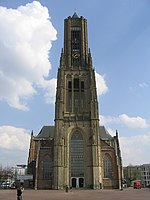John Frost Bridge
Bridges completed in 1948Bridges in GelderlandBridges over the RhineOperation Market GardenRijksmonuments in Arnhem ... and 3 more
Road bridges in the NetherlandsSteel bridges in the NetherlandsWorld War II sites in the Netherlands

John Frost Bridge (John Frostbrug in Dutch) is the road bridge over the Lower Rhine at Arnhem, in the Netherlands. The bridge was inaugurated after the end of World War II, and is named after Major-General John Dutton Frost (1912–1993), who commanded the British forces that reached and temporarily defended the pre-existing Rijnbrug ("Rhine Bridge") at the same location during the Battle of Arnhem in September 1944. This was the bridge referenced in the 1977 Anglo-American film A Bridge Too Far, although the IJssel bridge in Deventer was used for the actual shooting of the film.
Excerpt from the Wikipedia article John Frost Bridge (License: CC BY-SA 3.0, Authors, Images).John Frost Bridge
Nijmeegseweg, Arnhem
Geographical coordinates (GPS) Address External links Nearby Places Show on map
Geographical coordinates (GPS)
| Latitude | Longitude |
|---|---|
| N 51.974722222222 ° | E 5.9119444444444 ° |
Address
John Frostbrug (Oude Rijnbrug)
Nijmeegseweg
6833 AB Arnhem
Gelderland, Netherlands
Open on Google Maps











